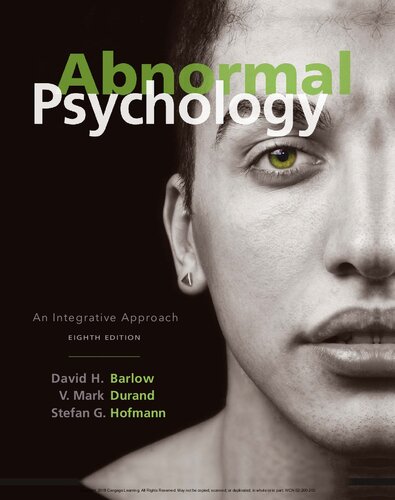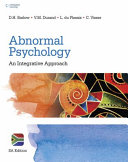(Ebook PDF) Abnormal Psychology An Integrative Approach 8th edition by David H Barlow, V Mark Durand, Stefan G Hofmann 978-1305950443 full chapters
$50.00 Original price was: $50.00.$25.00Current price is: $25.00.
Abnormal Psychology: An Integrative Approach 8th edition by David H. Barlow, V. Mark Durand, Stefan G. Hofmann – Ebook PDF Instant Download/DeliveryISBN: 978-1305950443
Full download Abnormal Psychology: An Integrative Approach 8th edition after payment.

Product details:
ISBN-13 : 978-1305950443
Author: David H. Barlow, V. Mark Durand, Stefan G. Hofmann
ABNORMAL PSYCHOLOGY: AN INTEGRATIVE APPROACH, Eighth Edition, is the perfect text to help you succeed in your abnormal psychology course! The authors — all internationally recognized experts in the field — show you how psychological disorders are rooted in multiple factors: biological, psychological, cultural, social, familial, and even political. You can test your understanding of topics with the text’s built-in concept checks and chapter quizzes.
Abnormal Psychology: An Integrative Approach 8th Table of contents:
Chapter 1. Abnormal Behavior in Historical Context
Understanding Psychopathology
What Is a Psychological Disorder?
The Science of Psychopathology
Historical Conceptions of Abnormal Behavior
The Supernatural Tradition
Demons and Witches
Stress and Melancholy
Treatments for Possession
Mass Hysteria
Modern Mass Hysteria
The Moon and the Stars
Comments
The Biological Tradition
Hippocrates and Galen
The 19th Century
The Development of Biological Treatments
Consequences of the Biological Tradition
The Psychological Tradition
Moral Therapy
Asylum Reform and the Decline of Moral Therapy
Psychoanalytic Theory
Humanistic Theory
The Behavioral Model
The Present: The Scientific Method and an Integrative Approach
Summary
Key Terms
Timeline of Significant Events
Chapter 2. An Integrative Approach to Psychopathology
One-Dimensional versus Multidimensional Models
What Caused Judy’s Phobia?
Outcome and Comments
Genetic Contributions to Psychopathology
The Nature of Genes
New Developments in the Study of Genes and Behavior
The Interaction of Genes and the Environment
Epigenetics and the Nongenomic “Inheritance” of Behavior
Neuroscience and Its Contributions to Psychopathology
The Central Nervous System
The Structure of the Brain
The Peripheral Nervous System
Neurotransmitters
Implications for Psychopathology
Psychosocial Influences on Brain Structure and Function
Interactions of Psychosocial Factors and Neurotransmitter Systems
Psychosocial Effects on the Development of Brain Structure and Function
Comments
Behavioral and Cognitive Science
Conditioning and Cognitive Processes
Learned Helplessness
Social Learning
Prepared Learning
Cognitive Science and the Unconscious
Emotions
The Physiology and Purpose of Fear
Emotional Phenomena
The Components of Emotion
Anger and Your Heart
Emotions and Psychopathology
Cultural, Social, and Interpersonal Factors
Voodoo, the Evil Eye, and Other Fears
Gender
Social Effects on Health and Behavior
Global Incidence of Psychological Disorders
Life-Span Development
The Principle of Equifinality
Conclusions
Summary
Key Terms
Chapter 3. Clinical Assessment and Diagnosis
Assessing Psychological Disorders
Key Concepts in Assessment
The Clinical Interview
Physical Examination
Behavioral Assessment
Psychological Testing
Neuropsychological Testing
Neuroimaging: Pictures of the Brain
Psychophysiological Assessment
Diagnosing Psychological Disorders
Classification Issues
Diagnosis before 1980
DSM-III and DSM-III-R
DSM-IV and DSM-IV-TR
DSM-5
Creating a Diagnosis
Beyond DSM-5: Dimensions and Spectra
Summary
Key Terms
Chapter 4. Research Methods
Examining Abnormal Behavior
Important Concepts
Basic Components of a Research Study
Statistical versus Clinical Significance
The “Average” Client
Types of Research Methods
Studying Individual Cases
Research by Correlation
Research by Experiment
Single-Case Experimental Designs
Genetics and Behavior across Time and Cultures
Studying Genetics
Studying Behavior over Time
Studying Behavior across Cultures
Power of a Program of Research
Replication
Research Ethics
Summary
Key Terms
Chapter 5. Anxiety, Trauma- and Stressor-Related, and Obsessive-Compulsive and Related Disorders
The Complexity of Anxiety Disorders
Anxiety, Fear, and Panic: Some Definitions
Causes of Anxiety and Related Disorders
Comorbidity of Anxiety and Related Disorders
Comorbidity with Physical Disorders
Suicide
Anxiety Disorders
Generalized Anxiety Disorder
Clinical Description
Statistics
Causes
Treatment
Panic Disorder and Agoraphobia
Clinical Description
Statistics
Causes
Treatment
Specific Phobia
Clinical Description
Statistics
Causes
Treatment
Social Anxiety Disorder (Social Phobia)
Clinical Description
Statistics
Causes
Treatment
Trauma and Stressor-Related Disorders
Posttraumatic Stress Disorder (PTSD)
Clinical Description
Statistics
Causes
Treatment
Obsessive-Compuslive and Related Disorders
Obsessive-Compulsive Disorder
Clinical Description
Statistics
Causes
Treatment
Body Dysmorphic Disorder
Plastic Surgery and Other Medical Treatments
Other Obsessive-Compulsive and Related Disorders
Hoarding Disorder
Trichotillomania (Hair Pulling Disorder) and Excoriation (Skin Picking Disorder)
Summary
Key Terms
Exploring Anxiety, Trauma- and Stressor-Related, and Obsessive-Compulsive and Related Disorders
Chapter 6. Somatic Symptom and Related Disorders and Dissociative Disorders
Somatic Symptom and Related Disorders
Somatic Symptom Disorder
Illness Anxiety Disorder
Clinical Description
Statistics
Causes
Treatment
Psychological Factors Affecting Medical Condition
Conversion Disorder (Functional Neurological Symptom Disorder)
Clinical Description
Closely Related Disorders
Unconscious Mental Processes
Statistics
Causes
Treatment
Dissociative Disorders
Depersonalization-Derealization Disorder
Dissociative Amnesia
Dissociative Identity Disorder
Clinical Description
Characteristics
Can DID Be Faked?
Statistics
Causes
Suggestibility
Biological Contributions
Real Memories and False
Treatment
Summary
Key Terms
Exploring Somatic Symptom and Dissociative Disorders
Chapter 7. Mood Disorders and Suicide
Understanding and Defining Mood Disorders
An Overview of Depression and Mania
The Structure of Mood Disorders
Depressive Disorders
Additional Defining Criteria for Depressive Disorders
Other Depressive Disorders
Bipolar Disorders
Additional Defining Criteria for Bipolar Disorders
Prevalence of Mood Disorders
Prevalence in Children, Adolescents, and Older Adults
Life Span Developmental Influences on Mood Disorders
Across Cultures
Among Creative Individuals
Causes of Mood Disorders
Biological Dimensions
Additional Studies of Brain Structure and Function
Psychological Dimensions
Social and Cultural Dimensions
An Integrative Theory
Treatment of Mood Disorders
Medications
Electroconvulsive Therapy and Transcranial Magnetic Stimulation
Psychological Treatments for Depression
Combined Treatments for Depression
Preventing Relapse of Depression
Psychological Treatments for Bipolar Disorder
Suicide
Statistics
Causes
Risk Factors
Is Suicide Contagious?
Treatment
Summary
Key Terms
Exploring Mood Disorders
Chapter 8. Eating and Sleep–Wake Disorders
Major Types of Eating Disorders
Bulimia Nervosa
Anorexia Nervosa
Binge-Eating Disorder
Statistics
Causes of Eating Disorders
Social Dimensions
Biological Dimensions
Psychological Dimensions
An Integrative Model
Treatment of Eating Disorders
Drug Treatments
Psychological Treatments
Preventing Eating Disorders
Obesity
Statistics
Disordered Eating Patterns in Cases of Obesity
Causes
Treatment
Sleep–Wake Disorders: The Major Dyssomnias
An Overview of Sleep–Wake Disorders
Insomnia Disorder
Hypersomnolence Disorders
Narcolepsy
Breathing-Related Sleep Disorders
Circadian Rhythm Sleep Disorder
Treatment of Sleep Disorders
Medical Treatments
Environmental Treatments
Psychological Treatments
Preventing Sleep Disorders
Parasomnias and Their Treatment
Summary
Key Terms
Exploring Eating Disorders
Exploring Sleep–Wake Disorders
Chapter 9. Physical Disorders and Health Psychology
Psychological and Social Factors That Influence Health
Health and Health-Related Behavior
The Nature of Stress
The Physiology of Stress
Contributions to the Stress Response
Stress, Anxiety, Depression, and Excitement
Stress and the Immune Response
Psychosocial Effects on Physical Disorders
AIDS
Cancer
Cardiovascular Problems
Hypertension
Coronary Heart Disease
Chronic Pain
Chronic Fatigue Syndrome
Psychosocial Treatment of Physical Disorders
Biofeedback
Relaxation and Meditation
A Comprehensive Stress- and Pain-Reduction Program
Drugs and Stress-Reduction Programs
Denial as a Means of Coping
Modifying Behaviors to Promote Health
Summary
Key Terms
Exploring Physical Disorders and Health Psychology
Chapter 10. Sexual Dysfunctions, Paraphilic Disorders, and Gender Dysphoria
What Is Normal Sexuality?
Gender Differences
Cultural Differences
The Development of Sexual Orientation
An Overview of Sexual Dysfunctions
Sexual Desire Disorders
Sexual Arousal Disorders
Orgasm Disorders
Sexual Pain Disorder
Assessing Sexual Behavior
Interviews
Medical Examination
Psychophysiological Assessment
Causes and Treatment of Sexual Dysfunction
Causes of Sexual Dysfunction
Treatment of Sexual Dysfunction
Paraphilic Disorders: Clinical Descriptions
Fetishistic Disorder
Voyeuristic and Exhibitionistic Disorders
Transvestic Disorder
Sexual Sadism and Sexual Masochism Disorders
Pedophilic Disorder and Incest
Paraphilic Disorders in Women
Causes of Paraphilic Disorders
Assessing and Treating Paraphilic Disorders
Psychological Treatment
Drug Treatments
Gender Dysphoria
Defining Gender Dysphoria
Causes
Treatment
Summary
Key Terms
Exploring Sexual Disorders and Gender Dysphoria
Chapter 11. Substance-Related, Addictive, and Impulse-Control Disorders
Perspectives on Substance-Related and Addictive Disorders
Levels of Involvement
Diagnostic Issues
Depressants
Alcohol-Related Disorders
Sedative-, Hypnotic-, or Anxiolytic-Related Disorders
Stimulants
Stimulant-Related Disorders
Tobacco-Related Disorders
Caffeine-Related Disorders
Opioid-Related Disorders
Cannabis-Related Disorders
Hallucinogen-Related Disorders
Other Drugs of Abuse
Causes of Substance-Related Disorders
Biological Dimensions
Psychological Dimensions
Cognitive Dimensions
Social Dimensions
Cultural Dimensions
An Integrative Model
Treatment of Substance-Related Disorders
Biological Treatments
Psychosocial Treatments
Prevention
Gambling Disorder
Impulse-Control Disorders
Intermittent Explosive Disorder
Kleptomania
Pyromania
Summary
Key Terms
Exploring Substance Use Disorders
Exploring Impulse-Control Disorders
Chapter 12. Personality Disorders
An Overview of Personality Disorders
Aspects of Personality Disorders
Categorical and Dimensional Models
Personality Disorder Clusters
Statistics and Development
Gender Differences
Comorbidity
Personality Disorders under Study
Cluster A Personality Disorders
Paranoid Personality Disorder
Schizoid Personality Disorder
Schizotypal Personality Disorder
Cluster B Personality Disorders
Antisocial Personality Disorder
Borderline Personality Disorder
Histrionic Personality Disorder
Narcissistic Personality Disorder
Cluster C Personality Disorders
Avoidant Personality Disorder
Dependent Personality Disorder
Obsessive-Compulsive Personality Disorder
Summary
Key Terms
Exploring Personality Disorders
Chapter 13. Schizophrenia Spectrum and Other Psychotic Disorders
Perspectives on Schizophrenia
Early Figures in Diagnosing Schizophrenia
Identifying Symptoms
Clinical Description, Symptoms, and Subtypes
Positive Symptoms
Negative Symptoms
Disorganized Symptoms
Historic Schizophrenia Subtypes
Other Psychotic Disorders
Prevalence and Causes of Schizophrenia
Statistics
Development
Cultural Factors
Genetic Influences
Neurobiological Influences
Psychological and Social Influences
Treatment of Schizophrenia
Biological Interventions
Psychosocial Interventions
Treatment across Cultures
Prevention
Summary
Key Terms
Exploring Schizophrenia
Chapter 14. Neurodevelopmental Disorders
Overview of Neurodevelopmental Disorders
What Is Normal? What Is Abnormal?
Attention-Deficit/Hyperactivity Disorder
Specific Learning Disorder
Autism Spectrum Disorder
Treatment of Autism Spectrum Disorder
Intellectual Disability (Intellectual Developmental Disorder)
Causes
Prevention of Neurodevelopmental Disorders
Summary
Key Terms
Exploring Neurodevelopmental Disorders
Chapter 15. Neurocognitive Disorders
Perspectives on Neurocognitive Disorders
Delirium
Clinical Description and Statistics
Treatment
Prevention
Major and Mild Neurocognitive Disorders
Clinical Description and Statistics
Neurocognitive Disorder Due to Alzheimer’s Disease
Vascular Neurocognitive Disorder
Other Medical Conditions That Cause Neurocognitive Disorder
Substance/Medication-Induced Neurocognitive Disorder
Causes of Neurocognitive Disorder
Treatment
Prevention
Summary
Key Terms
Exploring Neurocognitive Disorders
Major and Mild Neurocognitive Disorders
Chapter 16. Mental Health Services: Legal and Ethical Issues
Perspectives on Mental Health Law
Civil Commitment
Criteria for Civil Commitment
Procedural Changes Affecting Civil Commitment
An Overview of Civil Commitment
Criminal Commitment
The Insanity Defense
Reactions to the Insanity Defense
Therapeutic Jurisprudence
Competence to Stand Trial
Duty to Warn
Mental Health Professionals as Expert Witnesses
Patients’ Rights and Clinical Practice Guidelines
The Right to Treatment
The Right to Refuse Treatment
The Rights of Research Participants
Evidence-Based Practice and Clinical Practice Guidelines
Conclusions
Summary
Key Terms
References
People also search for Abnormal Psychology: An Integrative Approach 8th:
abnormal psychology: an integrative approach
6 psychology approaches
what is integrative approach
abnormal psychology an integrative approach epub
abnormal psychology an integrative approach 7th edition pdf
Tags:
David H. Barlow,V. Mark Durand,Stefan G. Hofmann,abnormal,psychology
You may also like…
Psychology - Psychological Disorders
Abnormal psychology: An integrative approach 1st Edition Cengage Learning
Psychology - Psychological Disorders
LooseLeaf for Abnormal Psychology: Clinical Perspectives on Psychological Disorders 8th Edition
Politics & Philosophy - Social Sciences
Abnormal Psychology and Life: A Dimensional Approach 3rd Edition
History & Research
The Psychology of Humor: An Integrative Approach 2nd Edition Rod A. Martin & Thomas E. Ford
Uncategorized
Abnormal Psychology: A Scientist-Practitioner Approach 4th Edition – Ebook PDF Version












